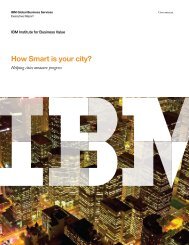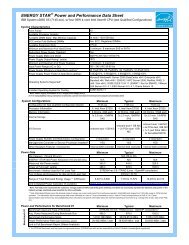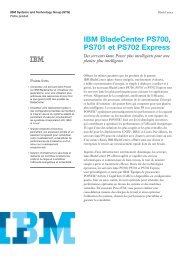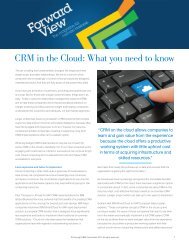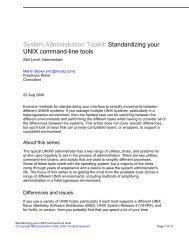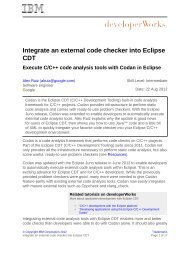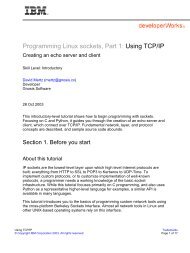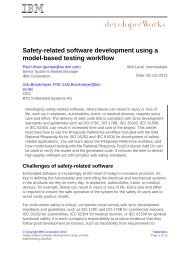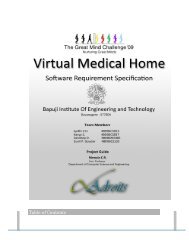Build a digital book with EPUB The open - IBM
Build a digital book with EPUB The open - IBM
Build a digital book with EPUB The open - IBM
Create successful ePaper yourself
Turn your PDF publications into a flip-book with our unique Google optimized e-Paper software.
developerWorks® ibm.com/developerWorks/<br />
• Specific fonts can be embedded in PDF to control the final output exactly.<br />
Three standards in one<br />
<strong>EPUB</strong> consists of three separate IDPF specifications, although in practice,<br />
it's safe to refer to them collectively as EPeUB:<br />
• Open eBook Publication Structure Container Format (OCF):<br />
Specifies the directory tree structure and file format (ZIP) of an<br />
<strong>EPUB</strong> archive.<br />
• Open Publication Structure (OPS): Defines the common<br />
vocabularies for the eBook, especially the formats allowed to be<br />
used for <strong>book</strong> content (for example, XHTML and CSS).<br />
• Open Packaging Format (OPF): Describes the required and<br />
optional metadata, reading order, and table of contents in an <strong>EPUB</strong>.<br />
Additionally, <strong>EPUB</strong> reuses several other standards, such as XHTML<br />
version 1.0 and Digital Accessible Information SYstem (DAISY), for specific<br />
types of content <strong>with</strong>in the <strong>EPUB</strong> archive.<br />
From a software developer's point of view, PDF falls far short of the ideal:<br />
• It's not a trivial standard to learn; therefore, it's not a simple matter to throw<br />
together your own PDF-generating code.<br />
• Although PDF is now an International Organization for Standardization (ISO)<br />
standard (ISO 32000-1:2008), traditionally it has been controlled by a single<br />
corporation: Adobe Systems.<br />
• Although PDF libraries are available for most programming languages, many<br />
are commercial or are embedded in GUI applications and not easily controlled<br />
by external processes. Not all free libraries continue to be actively maintained.<br />
• PDF-native text can be extracted and searched programmatically, but few PDFs<br />
are tagged such that conversion to a Web-friendly format is simple or reliable.<br />
• PDF documents aren't easily reflowable, meaning that they don't adapt well to<br />
small screens or to radical changes to their layouts.<br />
Why <strong>EPUB</strong> is friendly to developers<br />
<strong>EPUB</strong> addresses all the flaws in PDF as they relate to developer friendliness. An<br />
<strong>EPUB</strong> is a simple ZIP-format file (<strong>with</strong> an .epub extension) that contains files ordered<br />
in a proscribed manner. <strong>The</strong>re are a few tricky requirements about how the ZIP<br />
archive is prepared, which will be discussed in detail later in Bundling your <strong>EPUB</strong> file<br />
as a ZIP archive. Otherwise, <strong>EPUB</strong> is simple:<br />
• Nearly everything in <strong>EPUB</strong> is XML. <strong>EPUB</strong> files can be built using standard XML<br />
toolkits <strong>with</strong>out any special or proprietary software.<br />
• <strong>EPUB</strong> content (the actual text of an eBook) is almost always XHTML version<br />
1.1. (An alternative format is DTBook, a standard for encoding <strong>book</strong>s for the<br />
visually impaired. See Resources for more information on DTBook, which is not<br />
covered in this tutorial).<br />
• Most of the <strong>EPUB</strong> XML schemas are taken from existing, published<br />
specifications that are freely available.<br />
<strong>Build</strong> a <strong>digital</strong> <strong>book</strong> <strong>with</strong> <strong>EPUB</strong> Page 4 of 25



